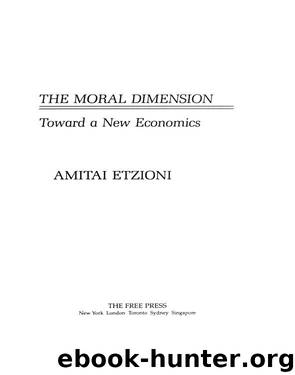THE MORAL DIMENSION by Unknown

Author:Unknown
Language: eng
Format: epub
Published: 2019-06-24T16:00:00+00:00
RULES CANNOT BE USED RATIONALLY
We have seen, so far, that the empirical evaluation of the use of rules seems inconclusive. Despite several sizable studies, conducted over decades, it is not possible to draw a firm conclusion whether or not rules enable their followers to act rationally, because the theory is insufficiently specified. While several case studies of organizations provide considerable plausibility to the thesis that the application of rules often leads to non-rational behavior, such studies, by their very nature of being “cases,” are not fully compelling. There is, though, a way to resolve the issue because it is possible to show that rules in many situations cannot provide rational guides. It is a matter of logic, not of empirical evidence. Thus we shall see that rules typically deal with one factor at a time, while most choices deal with multi-faceted situations; and that rules that advocate a certain course of action also advocate the opposite course, and so on. We hence need not study the effects of such rules; they just cannot work, on the face of it.
The discussion turns next to provide several reasons in support of the position that the use of rules is a priori non-rational in many circumstances.
1. Rules are typically advanced in isolation from one another rather than as parts of a comprehensive system. As a result, rules tend not to take into account that, in the real, complex, world, an efficient response to most challenges requires taking multiple considerations into account.
At the same time, there is no reason to deny that in some instances some simple rules prove very useful. The IRS is using numerous guidance rules, collated into Classification Handbook IRM 41(12)0. For example, the IRS pays special attention to children claimed as exemptions by separated parents, because they are often claimed by both, while only one claim is proper. Hence, while—because of the a priori reasons provided above—one may expect that rule-guided behavior will often be quite non-rational, this generalization is not expected to apply in every instance. As to the question, under what conditions the application of rules is relatively more rational? This seems to be a matter about which relatively little is known, which is one more reason why relying on them is not rational.
2. When individuals are provided with more than one rule, those rules often conflict with one another. For example, investors are advised to “buy low and sell high” (an ambiguous rule by itself, because no defintion of either “high” or “low” is included, and hence the rule invites investors to project their feelings on to the situation). Sometimes “high” or “low” refers to P/E (price/earnings) ratios. However, what is a high ratio is not agreed upon, and people are advised to invest in stocks of “high-growth” corporations despite the fact that their P/E ratios are often infinity because they initially show no profit at all. Investors are also advised “not to fight the tape” and to “let their profits run but cut their losses short,”
Download
This site does not store any files on its server. We only index and link to content provided by other sites. Please contact the content providers to delete copyright contents if any and email us, we'll remove relevant links or contents immediately.
The Art of Boudoir Photography: How to Create Stunning Photographs of Women by Christa Meola(18581)
Red Sparrow by Jason Matthews(5424)
Harry Potter 02 & The Chamber Of Secrets (Illustrated) by J.K. Rowling(3646)
In a Sunburned Country by Bill Bryson(3506)
Drawing Cutting Edge Anatomy by Christopher Hart(3484)
Figure Drawing for Artists by Steve Huston(3409)
Harry Potter and the Prisoner of Azkaban (Book 3) by J. K. Rowling(3323)
The Daily Stoic by Holiday Ryan & Hanselman Stephen(3264)
Japanese Design by Patricia J. Graham(3138)
The Roots of Romanticism (Second Edition) by Berlin Isaiah Hardy Henry Gray John(2888)
Make Comics Like the Pros by Greg Pak(2882)
Stacked Decks by The Rotenberg Collection(2842)
Draw-A-Saurus by James Silvani(2686)
Harry Potter and the Deathly Hallows (7) by J.K. Rowling(2680)
Tattoo Art by Doralba Picerno(2623)
On Photography by Susan Sontag(2607)
Churchill by Paul Johnson(2543)
The Daily Stoic by Ryan Holiday & Stephen Hanselman(2523)
Drawing and Painting Birds by Tim Wootton(2474)
